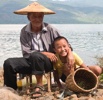 I bought one of Martin’s pork pies today. After too much yak in Shangri-La, I found myself lusting after something a little more in my own cultural tradition… But as I try to catch up with climate news, I find that Xian Ge Li La is in the news for all the wrong reasons:
I bought one of Martin’s pork pies today. After too much yak in Shangri-La, I found myself lusting after something a little more in my own cultural tradition… But as I try to catch up with climate news, I find that Xian Ge Li La is in the news for all the wrong reasons:
KUNMING, September 10 — One of China’s leading tourist landmarks, Meili Snow Mountain, will be devoid of snow within 80 years if global warming trends continue, a meteorological scientist warned on Monday. Liu Jiaxun also said China’s lowest and southernmost glacier, Mingyong, has shrunk by at least 40 meters over the past 13 years. The combined effects of ice melting and drying water sources would have devastating effects downstream, said Liu, deputy director of the Meteorological Bureau of Diqing Tibetan Autonomous Prefecture, in northeastern Yunnan Province. Mingyong — at 2,700 meters above sea level and 28.5 degrees north — had the lowest elevation and latitude of all China’s glaciers, said Liu. At 11.7 km long and covering 13 sq. km, it was shrinking faster than any other Chinese glacier, he said.
Sadly, during my visit to the Diqing Tibetan Autonomous Prefecture the Himalayas were shrouded in cloud. It rained. (Picture from Erhai Lake near Lijiang). Catching up will continue soon.
[Update: Pictures of the Meili Snow Mountain and glacier from China View here. The clouds cleared briefly, apparently…]



